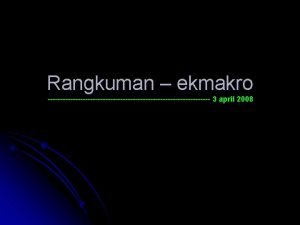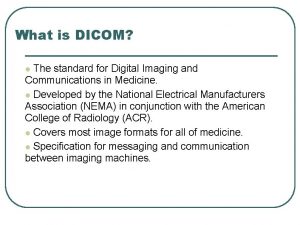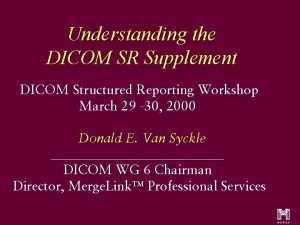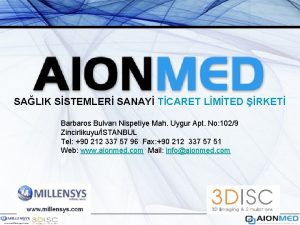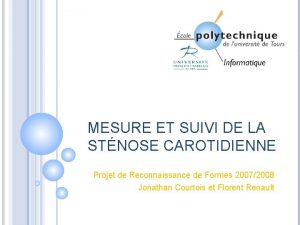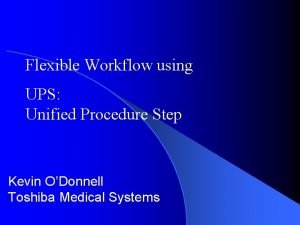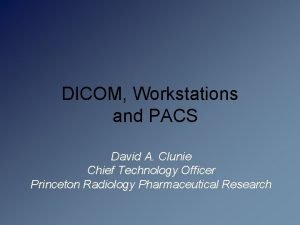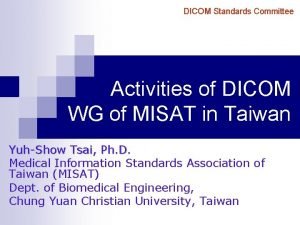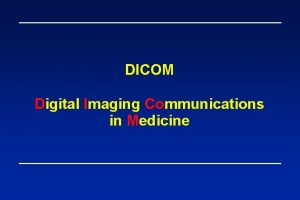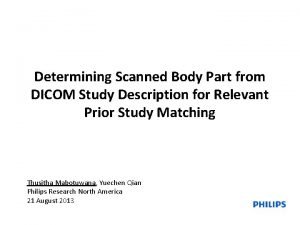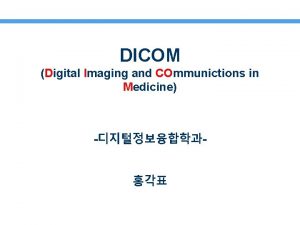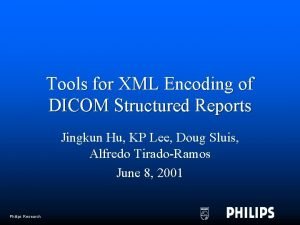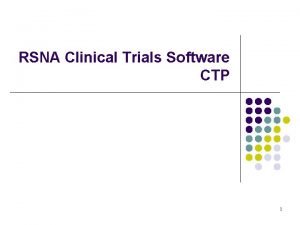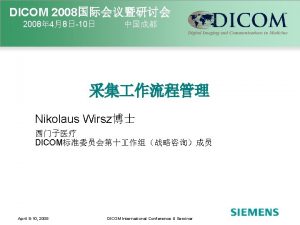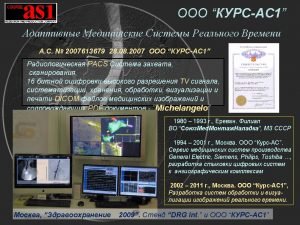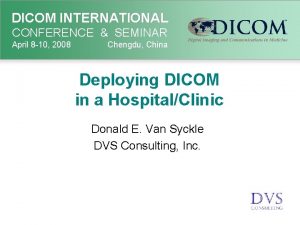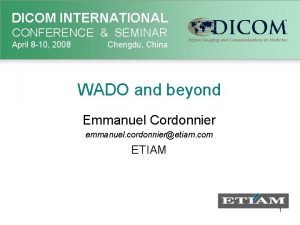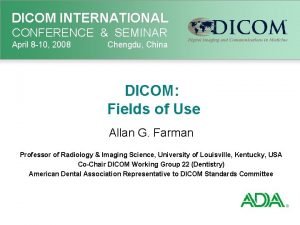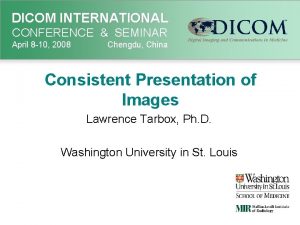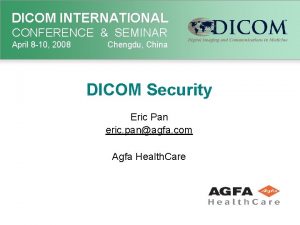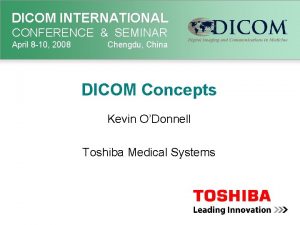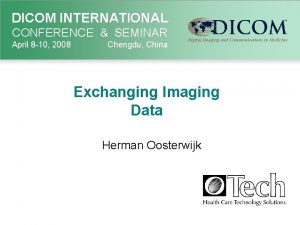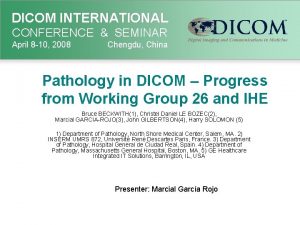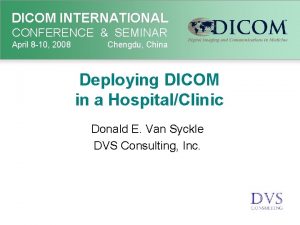DICOM INTERNATIONAL CONFERENCE SEMINAR April 8 10 2008



















- Slides: 19

DICOM INTERNATIONAL CONFERENCE & SEMINAR April 8 -10, 2008 Chengdu, China DICOM in Ophthalmology, an Example of a New Enhanced Multiframe Object Herman Oosterwijk Add logo if desired

Enhanced Multiframe • Objective: This presentation will answer the following question: – What are the major features of the new generation enhanced multiframe DICOM objects, how to understand this new type of object, and how does a typical enhanced multiframe look like, in particular OCT (Optical Coherence Tomography)

Enhanced multiframe: • Agenda: – Major features of the new generation of DICOM objects, i. e. enhanced multiframe – Steps to encode/decode this new type of object – OCT object, a sample enhanced multiframe

Traditional Multiframe objects: Vector • Single image, multiple frames • US, NM, XA, RF, SC, VL • Simple structure: – – # frames Frame rate Frame index pointer Frame increment pointer (NM)

Enhanced multiframe: • Why a new generation of objects: CT, MR, ophthalmology, mammography tomo, XA, RF – Imaging is moving from pixels in slices (2 -D) to voxels (3 -D) and beyond (n-D), i. e. time, space, frequency, flow: functional imaging (CTA, etc. ) – Simple “Study-Series-Image” hierarchy does not suffice anymore for organization, viewing, browsing, sorting using the appropriate hanging protocols – Text descriptions for Series leaves room for guessing

Sample application: Cardiac Imaging

Enhanced multiframe: • Solution: enhanced multiframe – Many Attributes are required (Type 1) – Where possible, Attribute contents are encoded – Definition of multiple dimensions – Header size reduction – Protocol efficiency: 1000 slice CT • 1000 times C-Store RQ…RS vs 1 time RQ…RS – ONE structure serving as a template for all new SOP Classes (CT, MR, XA, RF, OCT, MG…)

Dimension example: 313 Trigger Delay Time 5 4 3 2 1 Dimension Index Values ID 1 100 ms 5 4 50 ms 5 0 ms Time 4 3 3 2 2 1 ID 2 ID 3 1 1 Dimension Indexes (3): 1. Trigger Delay Time 2. Stack ID 3. Position

Enhanced multiframe encoding: • Split header: – Fixed information – Variable information (keep as minimum as possible) – Some information can be in both places (contrast) Header Part 1 Header Part 2 Pixels in frames Fixed per frame: Name, ID…. Accession #, Study ID… KV, m. As…. Orientation…. #rows, columns, bits Variable for one/more frames: Position Time Scab type

Enhanced multiframe: • Header part 2 (variable) definition: – Implemented as “functional groups”: SQ with zero, one, or more items – Documented as “macros” in Multi-Frame Functional Group Module – Common functional groups, used for multiple modalities, such as “Frame Content Macro” – Structure of dimensions, and concatenations is “generic”: Multi-frame functional group and dimension modules – Modality specific functional groups, e. g. for MR, ophthalmology, etc.

Functional groups:

Multiframe Functional Groups: Shared attributes Per-frame attributes Pixel data

OPT multiframe image sample:

Ophthalmology: IOD: IE Module Reference Usage Patient C. 7. 1. 1 M Study General Study C. 7. 2. 1 M Patient Study C. 7. 2. 2 U General Series C. 7. 3. 1 M C. 8. 17. X 1 M Series Ophthalmic Tomography Series Frame of Reference C. 7. 4. 1 C – Required if Reference Image available Synchronization C. 7. 4. 2 C – Required if Reference Image available Equipment General Equipment C. 7. 5. 1 M Enhanced General Equipment C. 7. 5. 2 M Image Pixel C. 7. 6. 3 M Enhanced Contrast/Bolus C 7. 6. 4 b C – Required if contrast was administered Multi-frame Functional Groups C. 7. 6. 16 M Multi-frame Dimension C. 7. 6. 17 M Acquisition Context C. 7. 6. 14 M Cardiac Synchronization C. 7. 6. 18. 1 C – Required if cardiac synchronization was used Ophthalmic Tomography Image C. 8. 17. X 2 M Ophthalmic Tomography Acquisition Parameters C. 8. 17. X 3 M Ophthalmic Tomography Parameters C. 8. 17. X 4 M C. 8. 17. 5 M C. 12. 1 M Image Ocular Region Imaged SOP Common

MULTI-FRAME FUNCTIONAL GROUPS MODULE ATTRIBUTES Attribute Name Shared Functional Groups Sequence Tag Type Attribute Description (5200, 9 229) 2 Sequence that contains the Functional Group Macros that are shared for all frames in this SOP Instance. 1 Sequence that contains the Functional Group Macros corresponding to each frame of the Multi-frame Image. >Include one or more Functional Group Macros that are shared by all frames. Per-frame Functional Groups Sequence (5200, 9 230) >Include one or more Functional Group Macros.

OPHTHALMIC TOMOGRAPHY FUNCTIONAL GROUP MACROS Function Group Macro Usage Pixel Measures M Frame Content M – May not be used as a Shared Functional Group. Plane Position C – Required if no Ophthalmic Photography Reference Image available Plane Orientation C – Required if no Ophthalmic Photography Reference Image available; May be present otherwise Referenced Image C – Required if Ophthalmic Photography Reference Image available. Derivation Image C – Required if the image or frame has been derived from another SOP Instance. Frame Anatomy M Cardiac Trigger C – Required if Cardiac Synchronization Technique (0018, 9037) equals other than NONE May be present otherwise. Contrast/Bolus Usage Ophthalmic Frame Location C – Required if Contrast/Bolus Agent Sequence (0018, 0012) is used. May not be used as a Shared Functional Group U

Enhanced multiframe: • Implementation issues: – Support by vendors, especially PACS archives and even more workstations: growing, but slowly – Mixed environments: new and old, especially for established modalities (CT, MR, XA, RF) – Handling very large files: concatenation (not allowed for OCT) – splitting up into mini-multi frames – Retrieval on frame level: to be added to standard

Conclusion: • New, enhanced multiframe objects are defined in DICOM, some for existing, some for new modalities • These new objects provide better interoperability for n-D (esp. dynamic) objects, allow for more sophisticated display protocols, and give better performance • Modalities, and to a lesser degree PACS systems are starting to support it; a mixed environment is inevitable

DICOM INTERNATIONAL CONFERENCE & SEMINAR April 8 -10, 2008 Chengdu, China Thank you! Herman Oosterwijk: herman@otechimg. com www. otechimg. com
 3 april 2008
3 april 2008 2008 2008
2008 2008 National sovereignty and childrens day
National sovereignty and childrens day International day april 4
International day april 4 What is dicom
What is dicom Dicom structured report
Dicom structured report Dicom nedir
Dicom nedir Stnose
Stnose Dicom lookup
Dicom lookup Dicom ups
Dicom ups Dicom workstation
Dicom workstation Dicomeye
Dicomeye Dicom network protocol
Dicom network protocol Study description dicom
Study description dicom Dicom gateway
Dicom gateway Enhanced dicom
Enhanced dicom Agfa dicom
Agfa dicom Dicom instance number
Dicom instance number Dicom structured report
Dicom structured report Rsna ctp anonymizer
Rsna ctp anonymizer
